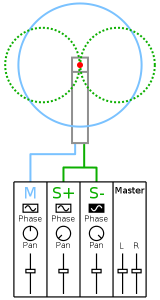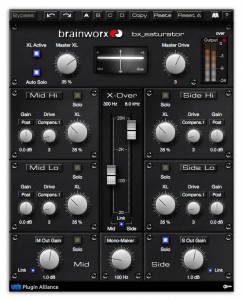Plugin Review: Brainworx bx_saturator
In today’s wide world of audio, mid-side processing is a feature that isn’t typically standard in effects plugins. Recently though, next-gen M/S plugins have become available and they are changing the way a lot of us are mixing – when this type of processing is done right (and with effects), it can achieve awesome results.
M/S was first realized in the analog recording world by utilizing a special M/S micing technique that essentially splits a single source into three separate channels using two microphones – a unidirectional mic and a bidirectional mic. This allowed the user more control over the sources space in the mix. That is all the control you could possibly ask for, right? Well what if it were multiband?
Back in late April, the German software developer Brainworx announced the first addition to their new “Brainworx Rock ´n ´Roll line”: The bx_saturator. This plugin was designed to work with mixing, mastering and sound design applications.
Bx_saturator is a mid/side multiband saturation plugin that excels in several respects: exaggerated distortion, simple operation, and — most notably — providing subtle saturation in a discrete way which analog tape and tube gear 0 typically accomplish the
best.
M/S processing plugins aren’t anything new to the plugin world, but the “mid/side” appeal is relatively new for saturation, and the bx_saturator is the result of this sector’s evolution. Bx_saturator isn’t the only saturation plugin on the market to offer M/S processing but, from what I’ve experienced, it is among the first to not only provide exaggerated effects, but to also effectively bring out subtleties and balancing of source tracks and master tracks.
With Brainworx’ history of excellent M/S mastering plugins, I already had high expectations. Now, after getting my hands on Bx_saturator and throwing it on everything but my salad, I have to say – I will be using this plugin on everything I mix from here on out! Read on to find out why…
The Layout
The bx_saturator is composed of several easy-to-comprehend sections.
Being as it is a multiband M/S processor, users have control over separate mid-high and mid-low sections as well as side-high and side-low sections – four “XL units” in total with individual “Solo,” “Gain,” “Drive,” and “XL” controls.
The frequency range for each section is determined by the X-Over Frequency controls where the user can set the point at which “high” and “low” channels are differentiated at any point between 20Hz-20kHz. The X-Over Frequency section also includes a Link mode which allows the Mid and Side x-over points to move together.
XL Units
The four XL Units are located to the left and right of the X-Over control area. These are what control the saturation characteristics of each channel – Mid-Hi, Mid-Low, Side-Hi, Side-Low. The XL Units make up a majority of the plugin and have the same controls for each respective box/unit.
The XL knob is responsible for controlling the level of distortion for the individual channels by creating additional harmonics. The addition of the harmonics is what actually helps to create the subtle saturation effect while aiding in balancing the dynamics of the
signal, without using compression or raising the level too drastically.
Another useful feature that is fun to experiment with is the pre/post modes for the “Gain” control found in all four of the XL units. Pre mode influences the amount of distortion being applied as ‘”Drive” is adjusted, while post offers more of a level control function, having no effect on the amount of distortion applied to your source.
The Drive control has two compensation modes as well. Compensation 1 mode makes up for the increase in level caused by drive by lowering its output. Compensation 2 does the same thing, just with a slightly higher output level. Compensation modes can be switched off but this will increase the output level caused by the Drive control.
With three separate saturation controls for just one XL unit, you can see how the simple layout is still very customizable.
Mono-Maker and Mid and Side Output Gain Controls
The very bottom of the plugin also includes some additional simple-yet-powerful features including a “Mono-Maker” knob that allows anything below the set frequency point to be summed to mono. Playing with this setting was interesting and actually helped tighten up the bass response of the masters it was applied to. Low frequencies in mono still sound big!
Outside of the Mono-Maker are the Output Gain Controls for Mid and Side channels. Both of these controls have their own solo buttons as well as a link mode to ensure they stay at the same level ratio with each other. Alternatively, users can disable link mode to adjust the Side Out Gain individually to control the perceived stereo width.
After taking into account the many options to control up to four sections of a single source channel, at different levels and frequencies, an understandable concern of mine was the daunting phase issue. Fortunately, Brainworx has implemented their new “True-Split” crossover technology that ensures that the mid and side channels are always in perfect phase with one another, eliminating any concern of phase issues with the bx_saturator.
Master XL, Master Drive, XL Bypass and Solo Option
Lastly, located at the very top of the plugin is the end of the saturators signal chain: The “Master XL” control, “Master Drive” control, “XL Active” bypass switch, “Auto Solo” switch and the plugin meters.
As you would have probably guessed, the Master Drive controls the output of all Drive controls within the four of the XL units while the Master XL controls the output of all four XL controls. Both of these master output controls have a unique feature in that it increases or decreases their respective subgroups’ values, maintaining the respected ratio the user already has set up. This feature is great for locating the right saturation sweet spot on your source.
Finally, XL Active engages or bypasses all four XL controls – the extra harmonics that are created on your source track. The XL active is another great tool for getting used to the plugin to see what “XL” actually does for your sound.
In Use
Understanding the difference in Drive and XL can become confusing when initially looking at the bx_saturator. The tools that helped me understand the audible qualities of the plugin quickly/easily were the master controls located at the top of the plugin.
Experimenting to find a balance between cranking and dialing down the Master Drive along with the Master XL, after applying some basic settings to all of the XL units, was a good place to start. Bypassing the XL Active switch made the process even easier to evaluate the two different audible qualities.
After getting a basic understanding of how the plugin worked, the thought of saturation on drums crossed my mind so I made it happen. Distorting the acoustic drums in a rock mix delivered typical results one might expect, but the bx_saturator’s distortion
sounded a bit more defined compared to other plugins I cross-referenced. My first experiments resulted in a lot of exaggerated distortion on percussion, vocals and guitar and they all produced the same “defined” results.
One test that further reinforced my trust in the plugin was placing it at the top of the signal chain on an acoustic/ambient master track. The vocal distortion at the end of the track wasn’t as present as it should have been but after a few simple tweaks, they popped and sounded very natural against the accompanying instruments without cluttering the mix.
The bx_saturator is great at being very transparent when you need it to be, but cranking it up to heavy distortion also sounded good on everything I put it on. It provides straight-up saturation that sounds crisp and clear.
As far as using the plugin to enhance, the bx_saturator did very well. When using the plugin on a single track or bus I found it very useful to apply it before actually EQ-ing or compressing.
Users will be surprised to find that this plugin can actually achieve what compressors and EQ’s do in one shot. The plugin achieves its EQ similarities by allowing control over certain frequencies and giving the user the choice to enhance the frequencies or not with Drive and XL control. The other half of its compressor similarities are actually achieved in the same actions as well as balancing of the mid and side channels to help create smoothed out dynamics.
Using the plugin on master/print tracks was also fun to A/B. Subtly raising the Drive on all of the XL units, once the proper x-over points were found, is excellent for increasing the perceived level and clarity without actually raising its level.
The bx_saturator is not the greatest for a wide variety of saturation effects as far as creating different sonic characteristics (popular amps, cabs or mics) but I don’t think that is the image that Brainworx aimed for when creating this plugin – bx_saturator co-exists nicely with other M/S saturation plugins on the market as well amp emulations plugins. It offers its own unique sonic characteristics for mixing and mastering.
Setting New Standards
The bx_saturator is a plugin that can accomplish multiple tasks in one instantiation, from balancing dynamics to eliminating low end phase issues. It can accomplish all these necessary tasks and then some, without completely altering or destroying the original sound that I still want to preserve.
These features are great for mixing and mastering applications, but the plugin can still be fun for creating audible distortion effects. With an introduction price of $190 ($229 MSRP) from Plugin-Alliance a straightforward plugin representing excellent value that is well worth investing in. A plugin that will bring a new quality to your mixes with no over-the-top features and an easy learning curve? What more could you ask for?
Audio Engineers and musicians will always have their favorite “go-to” plugins that will work for any situation. These obvious categories include EQs, Compressors, Limiters and Reverbs but the bx_saturator is a plugin that could very well become an addition to these categories that we think of when mixing. Place it on any source, or master buss and use it instead of an EQ or substitute it for a compressor. The results will surprise you!
— Gabriel Lamorie










Daniel
September 28, 2012 at 4:43 am (13 years ago)I’ll have to check this out. I bought the spl transient designer, which is also distributed by plugin alliance. Indispensable for me.